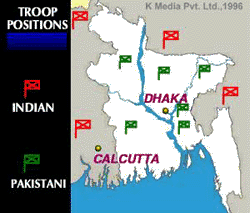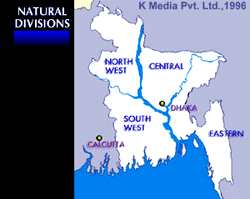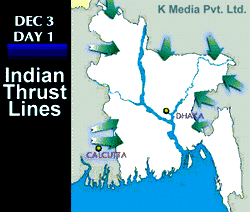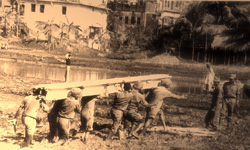![[Image: JPG Image og Indian Tank in Pakistani Territory; Caption: 1971 India-Pakistan War]](./media/1971WarPagesBanner.jpg)
![[Image: JPG Image og Indian Tank in Pakistani Territory; Caption: 1971 India-Pakistan War]](./media/1971WarPagesBanner.jpg)
| |
Modest Aims, Ambitious Action

|
One of the less remarked upon aspects of the 1971 war was the varied character of the key men who planned and executed the operations. Best known was of course the flamboyant Indian Army Chief, General Sam Maneckshaw, a Parsee who had won the Military Cross in WW II. To the Indian public, it was General Maneckshaw with his twirled moustache, Gorkha cap and baton, who was the symbolic hero. Yet, there were below him, an equally varied and extra-ordinary set of men, who planned and executed their own battles. The Western Army was commanded by an Anglo-Indian Lt. Gen. K.P.Candeth and the Eastern Army, headquartered at Calcutta, by a Sikh, Lt. Gen. J.S.Aurora. General Aurora's a brilliant Chief of Staff was Major. Gen. J.F.R.Jacob, the scion of an old Jewish family of Calcutta. Together these men planned and executed the lightning operations of December 1971.
The 4th morning saw Indian forces and Mukti Bahini guerrillas ready for battle with the Pakistanis, who were by now well dug in and waiting for the Indian assault. The Indian forces easily outnumbered the Pakistanis by a ratio of about 2:1. However, according to conventional infantry wisdom, an attacking Army requires a three-is-to-one superiority in numbers to attack. India did not have that. Besides, the Pakistani Army commander in the East, General A.A.K.Niazi, was determined merely to delay the Indian advance. For, in this war, the real battle was against time. The longer it took the Indian to secure their limited objectives, the greater the probability of the United Nations intervening to stop the war and effect a stalemate. Pakistan was confident that a stalemate was all that the Indians could get. Towards this strategy, General Niazi, had fortified the towns and approaches to the East Pakistani heartland and had boasted before the war began that should hostilities begin, he would take the battle inside India.

 The brief given by the Indian Army chief, General Maneckshaw, to the Eastern Command was very limited. The aim was to occupy only two areas of East Pakistan - Chittagong and Khulna - so that an interim Bangladeshi government could be established. The capture of the whole of East Pakistan was not even conceived. A major problem was the geography and terrain of East Pakistan. Three major rivers - the Brahmaputra, the Ganga and the Meghna - divided East Pakistan into four natural regions. Each of the rivers were major ones - all of them wider than any European river. Each sub-region was further divided into several pockets cut by smaller rivers and their tributaries. The idea that an attacking army could bridge these, fight the enemy and then take territory, all within a couple of weeks, was ludicrous.
The brief given by the Indian Army chief, General Maneckshaw, to the Eastern Command was very limited. The aim was to occupy only two areas of East Pakistan - Chittagong and Khulna - so that an interim Bangladeshi government could be established. The capture of the whole of East Pakistan was not even conceived. A major problem was the geography and terrain of East Pakistan. Three major rivers - the Brahmaputra, the Ganga and the Meghna - divided East Pakistan into four natural regions. Each of the rivers were major ones - all of them wider than any European river. Each sub-region was further divided into several pockets cut by smaller rivers and their tributaries. The idea that an attacking army could bridge these, fight the enemy and then take territory, all within a couple of weeks, was ludicrous.
 |
Lt. General Aurora's Chief of Staff, Major General Jacob, however, did not entirely agree with the Indian Army top brass. "I think the aim of the government was to take as much territory as possible in East Pakistan so as to establish an Bangladeshi government in their own territory," he recalled in an interview with SAPRA INDIA. "Army Headquarters issued an operations instruction according to which our main objectives were to take Chittagong and Khulna ports, which were termed the entry ports. But we at Eastern Command felt differently. We felt that Dhaka was the geo-political centre of Bangladesh and therefore any campaign to be successful had to capture Dhaka."
 The Eastern Command went ahead with its own plans, although Army Headquarters felt it was too ambitious and could not be achieved. Jacob's commander, Lt. Gen. Aurora, provided full support for his Army's own plans and allowed Jacob to pull down troops kept in reserve for a possible attack by the Chinese. Some of these troops had to be brought into battle so hurriedly that the only way was to paradrop them. This was accomplished with the help of the IAF and soon soldiers geared to fight the Chinese in the high mountains found themselves in the tropical riverine areas of Tangail in East Pakistan.
The Eastern Command went ahead with its own plans, although Army Headquarters felt it was too ambitious and could not be achieved. Jacob's commander, Lt. Gen. Aurora, provided full support for his Army's own plans and allowed Jacob to pull down troops kept in reserve for a possible attack by the Chinese. Some of these troops had to be brought into battle so hurriedly that the only way was to paradrop them. This was accomplished with the help of the IAF and soon soldiers geared to fight the Chinese in the high mountains found themselves in the tropical riverine areas of Tangail in East Pakistan.
"We realised that any campaign to be successful had to be swift. The United Nations was putting great pressure on us and also the Russians had indicated that they did not want to exercise their veto any more," Jacob explained. "Therefore any campaign had to be quick. We realised that Niazi (the Pakistani Army commander in East Pakistan) was going to fortify the towns and defend them in strength. We therefore decided not attack any towns but bypass them using subsidiary tracks to get to our objective: Dhaka."
 The immense practical problem of moving thousands of troops and tonnes of equipment across rivers and marshes was accomplished largely due to the efforts of the Army Corps of Engineers, and with a lot of local help. The IAF chipped in by using helicopters to lift entire battalions across larger rivers that could not be quickly bridged by the Engineers. In most places, the swiftly moving contingents quickly overcame enemy resistance and moved forward. The Pakistanis for the most part, were completely taken by surprise.
The immense practical problem of moving thousands of troops and tonnes of equipment across rivers and marshes was accomplished largely due to the efforts of the Army Corps of Engineers, and with a lot of local help. The IAF chipped in by using helicopters to lift entire battalions across larger rivers that could not be quickly bridged by the Engineers. In most places, the swiftly moving contingents quickly overcame enemy resistance and moved forward. The Pakistanis for the most part, were completely taken by surprise.
Within 6 days of the war, Indian troops were deep inside East Pakistani territory and moving fast. The Mukti Bahini section of the advancing forces played a crucial role in guiding the Indian Army through the treacherous riverine areas and providing critical intelligence. It is doubtful whether the Indian Army could have moved so fast and decisively without the help of the Bangladeshis. At any rate, by the seventh day of the war, the Pakistani Army High Command, headquartered in Rawalpindi, was in a complete panic.


